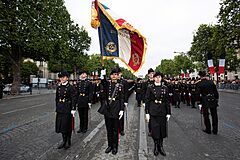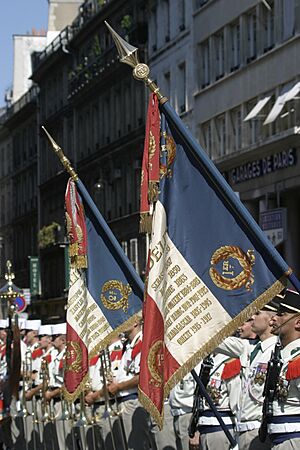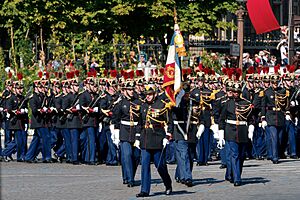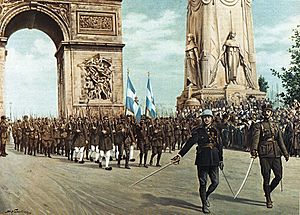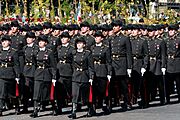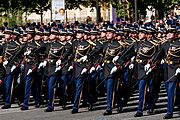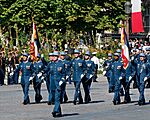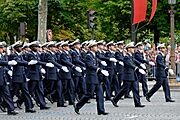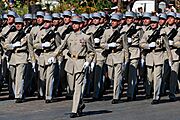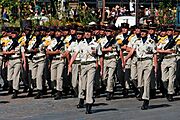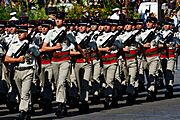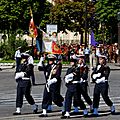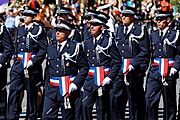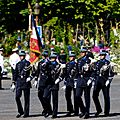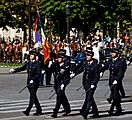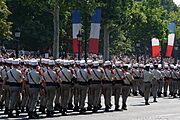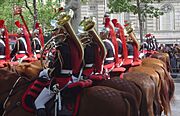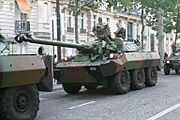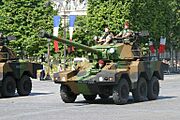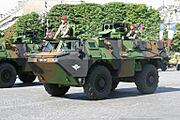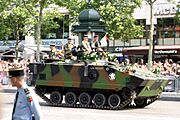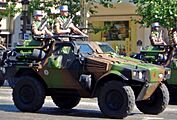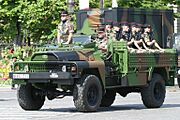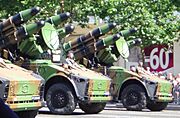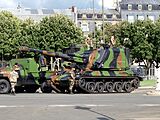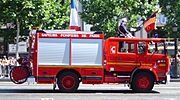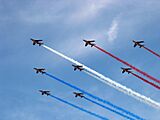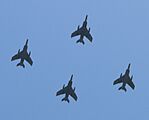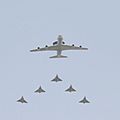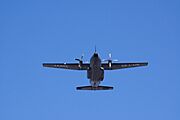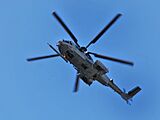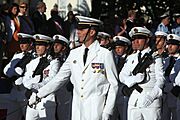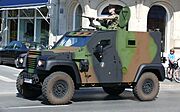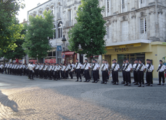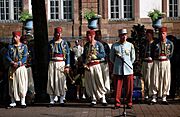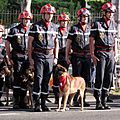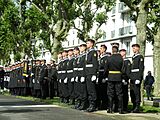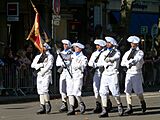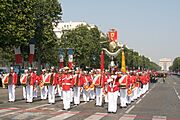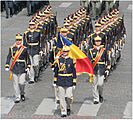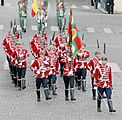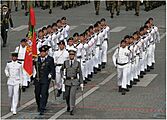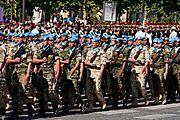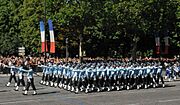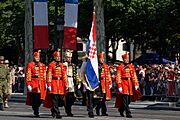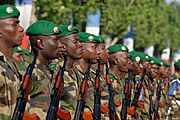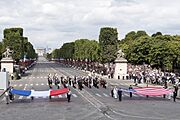Bastille Day military parade facts for kids
Quick facts for kids Bastille Day military parade |
|
|---|---|

|
|
| Official name | Défilé du 14 juillet |
| Observed by | |
| Celebrations | Military parade |
| Begins | 1880 |
| Date | 14 July |
| Next time | 14 July 2026 |
| Frequency | Annual |
| Related to | Bastille Day |
The Bastille Day military parade is a famous French military parade held every year on the morning of July 14th. This date is a national holiday in France called Bastille Day. The parade has taken place in Paris almost every year since 1880, making it one of the oldest military parades in the world.
The parade travels down a famous street called the Avenue des Champs-Élysées. It starts at the Arc de Triomphe and ends at the Place de la Concorde. The President of France, government officials, and guests from other countries watch the parade from a special viewing stand.
It's a very popular event for French people and is shown live on TV. Sometimes, soldiers from other countries are invited to march in the parade. Smaller parades also happen in other French cities like Marseille and Toulon.
Contents
What Happens During the Parade?
The parade is a carefully planned event with many exciting parts. It begins when the President of France arrives at the Arc de Triomphe. He inspects the troops, riding in a special vehicle down the Champs-Élysées while waving to the crowds.
Before the main parade starts, military bands often perform music and marching routines. Choirs sing famous French patriotic songs, and the event officially kicks off with the French national anthem, La Marseillaise.
The parade itself starts with a fly-past. The Patrouille de France, the French Air Force's aerobatic team, flies overhead, leaving trails of red, white, and blue smoke in the sky.
Next come the soldiers marching on foot. First are the cadets from France's top military schools, like the École Polytechnique and Saint-Cyr. They are followed by soldiers from the army, navy, air force, and the national police force, known as the Gendarmerie.
An interesting tradition involves the French Foreign Legion. They always march last among the foot soldiers because their marching speed is slower than other units.
After the foot soldiers, the motorised troops roll down the avenue. This part of the parade includes armored vehicles, tanks, and other military trucks. The parade traditionally ends with the popular Paris Fire Brigade, which is a part of the French Army. The event often closes with a thrilling parachute display by skydivers from the French Armed Forces.
History of the Parade
Bastille Day became France's official national holiday in 1880. A law passed that same year decided that a military parade should be part of the celebration. At first, the parade was held at the Longchamp Racecourse in Paris.
A New Location After World War I
After World War I, the parade moved to the famous Avenue des Champs-Élysées. The first parade there was the défilé de la Victoire ("Victory parade") on July 14, 1919. This huge parade celebrated the end of the war. Soldiers from all the Allied countries that fought with France, including Britain and the United States, marched together.
During World War II, German troops who occupied Paris held their own parades on the same route. However, French soldiers who had escaped to London continued the tradition by parading there. After Paris was freed in 1944, a massive victory parade was held in 1945 to celebrate.
Modern Parades and Special Guests
In recent decades, the parade has often included special guests to celebrate friendships between countries.
- 1994: German soldiers marched in the parade for the first time. This was a powerful symbol of peace and friendship between France and Germany.
- 2004: To celebrate 100 years of friendly relations with Britain, known as the Entente Cordiale, British troops led the parade.
- 2009: Soldiers from India were the guests of honor, and they marched down the Champs-Élysées to the sound of Indian military music.
- 2014: To mark 100 years since the start of World War I, soldiers from over 70 countries that were involved in the war marched together.
- 2017: The President of the United States, Donald Trump, was the guest of honor to remember the 100th anniversary of the U.S. entering World War I. American troops marched alongside French soldiers.
- 2023: The Prime Minister of India, Narendra Modi, was the guest of honor. Soldiers from the Indian Army, Navy, and Air Force marched in the parade to celebrate 25 years of partnership between India and France.
- 2024: The parade was held in a different location to prepare for the 2024 Summer Olympics in Paris. It honored the 80th anniversary of the D-Day landings and the Liberation of France during World War II.
Who Takes Part in the Parade?

The Bastille Day parade is the largest regular military parade in Western Europe. It features thousands of participants.
- Soldiers on Foot: Around 7,800 soldiers march in the parade. This includes cadets from military schools, infantry soldiers, paratroopers, sailors, and airmen. Police officers and firefighters also march.
- Vehicles: Over 300 vehicles, including tanks, armored cars, and fire trucks, are part of the mobile column.
- Horses: The famous cavalry of the French Republican Guard includes about 240 horses.
- Aircraft: More than 80 planes and helicopters participate in the fly-past, showing off the power of the French Air Force and Naval Aviation.
Gallery
Infantry parade
-
Cadets of the École polytechnique
-
Cadets of the École de l'air
Mounted/Motorised parade
-
AMX 10 RC tank destroyer
-
VBL Armoured light vehicle
-
The Paris Fire Brigade closing the motorised parade
Air parade
-
The Patrouille de France's Alphajets
-
A Boeing E-3 Sentry (AWACS) followed by five Mirages 2000
Local parades
-
Fusiliers-marins from Toulon naval base parading in Toulon.
-
PVP of the 3rd regiment engineers, 1st Mechanised Brigade in Charleville-Mézières
-
French Air Force riflemen in Rochefort.
-
1st Tirailleurs of Épinal regiment displaying late 19th century uniforms for Bastille Day in Strasbourg.
-
Cynotechnical unit of the Marseille Naval Fire Battalion during the military parade of 14 July 2012 in Marseille, with a decorated dog.
-
Russian and Mexican sailors during the military parade of 14 July 2012 in Brest.
-
7th Battalion of the Chasseurs Alpins during Bastille Day parade in Lyon.
Foreign guests
-
In 2007, one regiment from each European member-state paraded on the Champs-Élysées (here, the 30th regiment of the Romanian National Guard)
-
The Indian Air Force contingent, led by the India's oldest regiment, the Maratha Light Infantry, guest participants in 2009.
-
In 2013, Malian troops opened the parade following French involvement in the Malian civil war
-
In 2017, US President Donald Trump attended the Bastille Day parade in Paris at the invitation of President Emmanuel Macron
Images for kids
See also
 In Spanish: Desfile militar del Día de la Bastilla para niños
In Spanish: Desfile militar del Día de la Bastilla para niños


